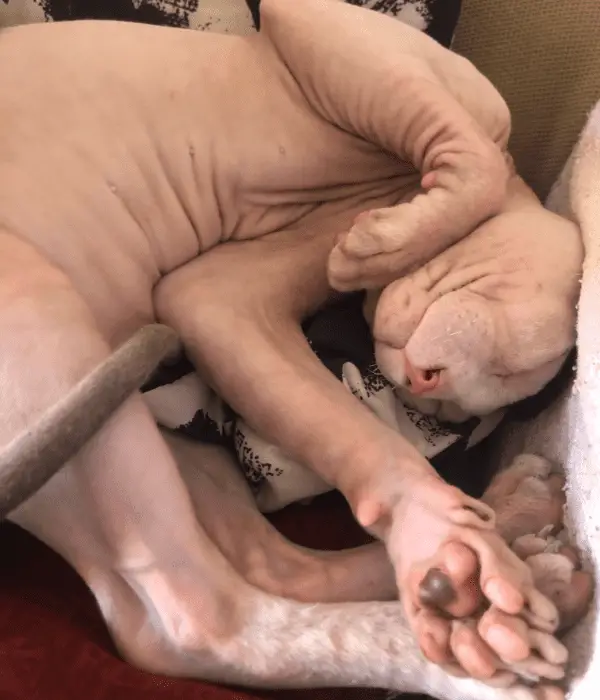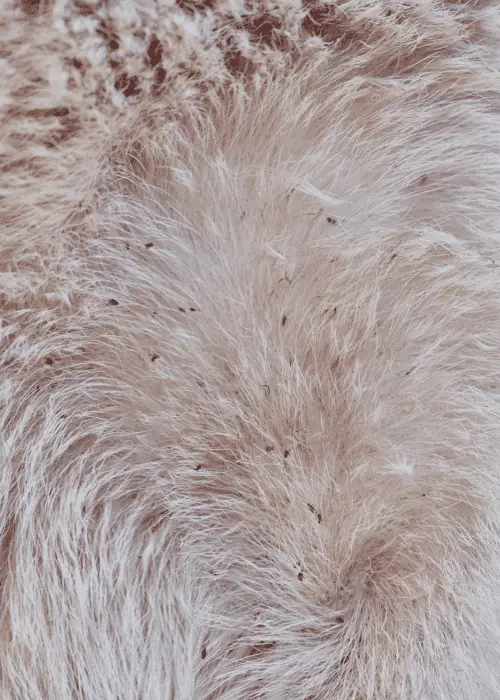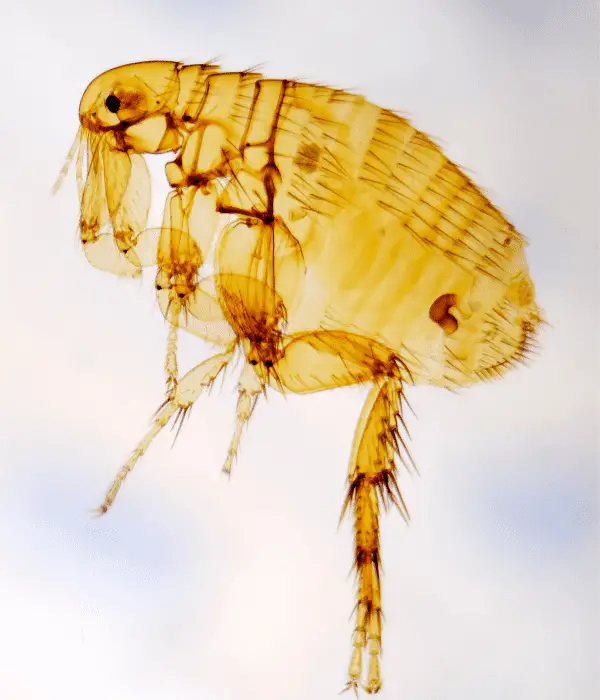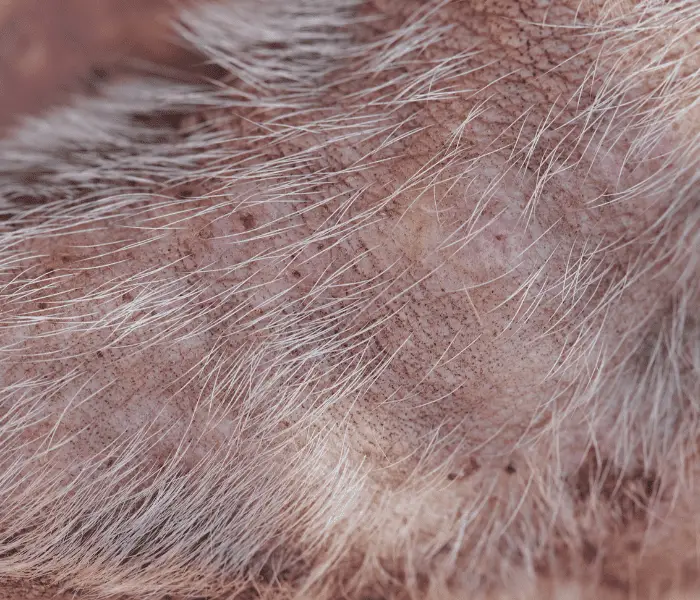This article contains affiliate links, and we may earn a commission at no cost to you if you choose to purchase through these links. I never recommend products that I do not trust or will not advise my veterinary clients and patients to use.

While a sphynx may not look like the average furry cat, it, unfortunately, does not get to escape the pests and parasites that plague the feline species. Your sphynx is indeed susceptible to flea infestation, but the good news is that it is easier to deal with than it is in their furry relatives.
Fleas are host-non-specific, meaning they do not discriminate between mammalian species, fur, or no fur. Therefore, fleas will jump onto a sphynx and bite them, but they will most likely not stay for too long as there is no hair for them to grip onto or to hide in.
Fleas are horrible pests that are hard to get rid of once they appear in a home. It can take up to a year to completely rid a home of fleas, so the saying that prevention is better than cure certainly applies here! This article explains how this parasite impacts sphynx cats and what you can do to treat and prevent a flea infestation if you own sphynx cats.
The Basics On Fleas
Fleas are insects (with six legs and three body segments) that live the adult stage of their life cycle on mammals, where they bite into the skin to feed on blood. They are host-non-specific, meaning they do not discriminate between species and will bite your pets, strays, and even you and your family.
A sphynx cat is no exception to this; even though they may be hairless, they are still mammals and fall on the list of flea hosts. Their advantage over their furry friends is that fleas are less likely to hang around since there is nothing for them to grip onto or hide in when hair is absent.
Flea eggs are resistant to desiccation and can remain in an environment for months. The life cycle of fleas is temperature dependant and varies from weeks to months, being shorter in the warmer weather and longer in the colder months. Meaning that adults reproduce quicker and eggs hatch within a shorter period when the weather is warm.
If you find fleas in your home, only 5% of the fleas are on the pet, and 95% of the fleas reside in the environment. For this reason, if you find fleas one of your pets, strict year-round flea control will be needed for at least the next 12 – 18 months.

Some Common Fleas That May Infest Cats Include:
- Human flea (Pullex irritans)
- Sticktight fleas (Echidnophaga spp)
- Jumping flea of cats (Ctenocephalides felis) – it may be important to note that this is actually the most common flea of dogs, as opposed to the jumping flea of dogs (Ctenocephalides canis), because if you have dogs around, they may be the source of the fleas for your sphynx cat.

Fleas Can Transmit Disease!
While causing severe irritation, the fleas listed above may also transmit some other diseases to a sphynx and a human.
The Human flea (Pullex irritans) was the causative agent of the bubonic plague (Yersinia pestis), which caused such an iconic pandemic in history.
The sticktight fleas (Echidnophaga spp) are called such because they burrow their heads into the skin. They commonly do so on the ears of cats (and dogs), causing severe irritation, which may predispose the cat to other infections in that area since the integrity of the skin is compromised by the initial insult of the fleas.
The jumping flea of cats (Ctenocephalides felis) is a common culprit for allergic skin reactions in cats and severe pruritus, i.e., itchiness.
Flea Bite Allergy – The Threat Fleas Have On Sphynx Cats
Flea bite allergy or Flea Allergic Dermatitis (FAD) is the most common cause of itchy and inflamed skin in cats. An estimated 60% of feline dermatitis cases are caused by an allergy to flea saliva. In sphynx cats, this typically appears as red bumps and sometimes crusty spots on the skin. This type of skin lesion is often called milliary dermatitis.
Flea bite allergy is severely itchy and can cause considerable discomfort for animals suffering from this condition. In the case of Sphynx cats, it may even result in permanent scarring or darker patches of skin, even after the condition has been resolved.

The good news? This is easier to see on a sphynx due to the absence of fur. Flea bite marks are much easier to spot on your sphynx’s skin, and while sphynx cats are not avid groomers, per se, you might notice your sphynx gnawing or excessively licking at a specific part of their body after a flea has bitten them.
A flea bite allergy does not always present as an obvious skin reaction and may concurrently or independently occur with pruritic otitis (itchy ear infection). Keep an eye on whether your cat is grooming its ears excessively. Bare in mind that sphynx cats are prone to over-production of ear wax, which may also cause this abnormal behavior (Cusidó Mas, 2021).
An estimated 60% of feline dermatitis cases are caused by an allergy to flea saliva
Treatment
Since the severity of a flea bite allergic reaction can vary, even in the same animal, on different occasions, please speak to your veterinarian about the proper way to resolve such an issue. Luckily, it is uncommon for a flea bite allergy to cause such a severe reaction that it classifies as an emergency, although it can cause considerable discomfort.
If you are having a busy day and can only get to the vet at a later stage, soothing topical formulations may help relieve your cat’s immediate itch. However, it is vital to check on the labels that these are safe for use in cats, as cats groom themselves and, therefore, may ingest the lotion.
As always, prevention is better than treatment. Some flea control strategies are explored below.
Flea Control
Flea infestations should be addressed through an integrated approach involving flea control on your pets and flea control in the environment.
All the pets in your home should be on flea treatment. Depending on your country, you may need a script from your vet for flea products. Spot-on formulations such as Advantage or Frontline work well on furry pets.
The usual pour-on or spot-on formulations used to control fleas in cats are not so easy to use o Sphynx cats. This is because these topical formulations often just run off the skin, and the total dose may not be absorbed as intended.
In addition, sphynx cats have a naturally higher oily content in their skin which may interfere with the absorption of the product (and in any way increase run-off). In light of this, it would be wise to adopt another, more effective method of flea control for a sphynx.
Pet Vet Tip: to read more on the skin conditions of sphynx cats, and how to take care of their ears, have a look at the linked articles on our website.
A couple of effective flea-preventative methods are discussed below:
1. Flea collar
Getting a collar for your cat that is impregnated with a formulation that repels and kills fleas (and ticks – for added benefit) is a good option. The only thing to consider with this option is your cat’s tolerance to a collar. If they are not a fan of it, it has been stated that cats can become receptive over time (Fink et al., 2016).
Seresto is a popular and trusted brand of flea collars that will keep fleas off your cat for eight months.
2. Oral Tablets
Chewable tablets are also available to deliver flea control to your cat. Of course, not all cats are equally easy to pill, but most of the oral tick and flea formulations are chewable, tasty, and tolerated by most cats (sometimes disguised in some of their favorite treats).
An example of such medication is Capstar which kills adult ticks and starts working within 30 minutes of administering the tablet. However, the downside of Capstar is that it only lasts for 24-48 hours but is available without a prescription in most countries. For this reason, we recommend only using Capstar in the case of an emergency until a longer-lasting treatment can be obtained.
Credelio is another flea tablet for cats eight weeks and older, weighing more than 2 pounds (approximately 1 kilogram) and lasting for one month. It’s a chewable tablet that most food-motivated cats will eat as a treat.
3. Spot-On
Although spot-ons work better on furry-coated animals, there is a way to make it work in sphynx cats. We need to provide them with a temporary ‘coat’ for a couple of days. You can do this by applying the flea product as usual and then putting a collared (polo-neck) cat shirt on for four days after applying the spot-on product to keep it in contact with the skin to be absorbed.
A good example would be this lightweight cat shirt with a high collar. Just note that tick and flea spot-on may stain the material.
A Caution On Topical Tick and Flea Products
It is crucial to ensure that you select a product specifically for cats and apply it to an area on their bodies where your cat can not lick. Accidentally using a dog product on your cat can result in severe symptoms of toxicity, such as twitching muscles, salivation, and weakness, since cats are very sensitive to active ingredients from the permethrin group.
If your cat happens to digest a topical cat flea preventative, it may result in transient excessive salivation.
Treating The Environment
Since 95% of fleas reside in the environment, it is even more important to treat your home for fleas. This can be rather challenging as flea eggs are very resistant to desiccation. The following three methods can help remove fleas and flea eggs from the environment:
1. Vacuuming
Vacuum under furniture and in all the corners and cracks of your home. Repeated vacuuming increases the rate of removing fleas from the environment, not only by removing more eggs, but vacuuming will also cause transient heat in relatively cool and dark places that will stimulate pupae to hatch, making it easier to be picked up by a vacuum.
2. Wash All The Pet Bedding
All the material and bedding your pets are in contact with should be washed in hot water and dried in direct sunlight.
This includes carpets, sofas, pillow covers, pet beds, and your bedding if they sleep on your bed.
3. Treat The Environment With Chemicals
Consult pest control on an appropriate pet-safe chemical to use and treat all dark and shaded areas.
Environmental treatment is the least effective of all the flea treatment strategies, as very few chemicals are effective in killing flea eggs. Chemically treating the environment also carries the highest risk as these chemicals often do not undergo the same stringent tests as topical or oral flea treatments. However, treating the environment is still essential to the treatment strategy for severe flea infestation.
Conclusion
In conclusion, fleas can indeed infest a sphynx cat, although they do not cause chronic infestation issues as they do in furry breeds. Proper flea control is, therefore, still imperative if you own a sphynx.
While controlling the flea burden of your sphynx directly, it is also vital to control the flea burden of the environment your cat lives in. This includes properly cleaning all bedding regularly, as well as the carpets, couches, beds, etc., that your cat enjoys sleeping on in the house.
If you have other animals with hair in the household that may serve as reservoirs for fleas, which may then jump on and off of your hairless sphynx, it is essential to ensure that they are on a good flea control program as well.
Resources
- CUSIDÓ MAS, M. 2021. Dermatology of the sphynx cat: a review and a study of the incidence of dermatologic problems in HCV-UAB.
- FINK, H., WENNOGLE, S., DAVIS, W. L., VON SIMSON, C. & LAPPIN, M. R. 2016. Field comparison of tolerance of a collar containing 10.0% imidacloprid/4.5% flumethrin (Seresto) and a placebo collar placed on cats. Journal of feline medicine and surgery, 18, 1031-1033.
- Genovese, D., Johnson, T., Lamb, K. and Gram, W., 2014. Histological and dermatoscopic description of sphynx cat skin. Veterinary Dermatology, [online] 25(6), pp.523-e90. Available at: <https://onlinelibrary.wiley.com/doi/abs/10.1111/vde.12162>.
- KUNKLE, G. A., MARSELLA, R. & NICKLIN, C. 2000. A scoring index for clinical signs of flea allergy dermatitis in the cat. Veterinary Therapeutics, 1, 213-219.

